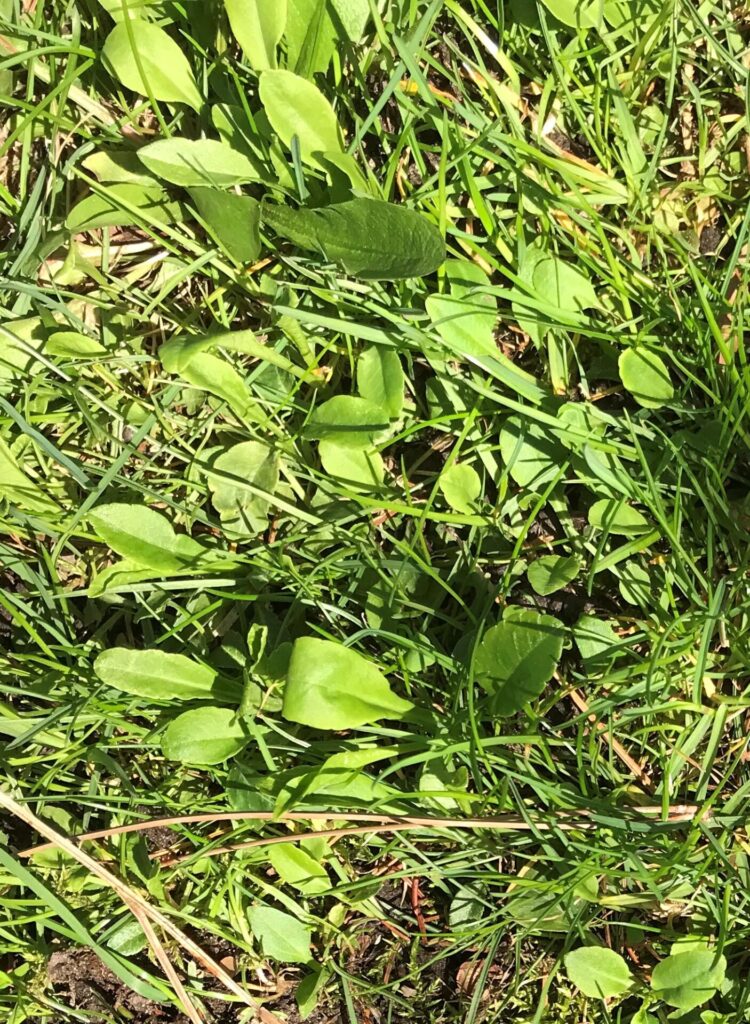
Hello. I moved into a new (to us) home three years ago, where the lawn had been let go. I don’t use herbicides, so have been weeding manually and, where I can, replacing patches, but I just can’t get rid of this weed. Could you please tell me what it is and how I might deal with it? (I have other photos if they would help, but could only send one via this contact form.) Thank you.
Thank you for contacting the Toronto Master Gardeners concerning your lawn. It is often difficult to identify a plant, especially a weed, from the young juvenile leaves. Plant identification is usually based on plant morphology- the overall size of the plant, the shape of the adult leaves, are the leaves alternate, opposite, whorled or decussate, type of flower produced etc.
You may wish to download a FREE plant identification app, such as Picture This or iNaturalist, on your smartphone for an accurate identification.
Just from the image you sent my initial guess would be Shepherd’s Purse, an annual weed in the mustard family. This weed grows from a rosette of lobed leaves from it’s base and produces small white flowers. Due to the Ontario’s pesticide ban one is limited as to what you can use to treat this weed. Hand pulling along with making sure the weed does not set seed are two methods which will slow the spread of the weed.
Maybe it’s time to start from scratch? You can try covering the lawn with either black tarp or clear plastic film; both will work, as they aim to kill weeds using different means. Black is used where the intent is to starve the weeds to death by preventing them from photosynthesizing, while clear plastic is used where you want to “cook” the weeds to death.
Please take a look at the following answer from one of our archived posts for further information on both processes:
“Covering the ground with thick black plastic is an effective way to kill weeds. At first the weeds will begin to grow rapidly due to the heat under the black plastic however over time they will die from lack of food. Essentially, the weeds will starve since they cannot produce food through photosynthesis and eventually will exhaust their food supply and starve. This method takes time and will only work as long as no light reaches the plant.
Another effective non-chemical technique to eradicate weeds is through solarization. According to the University of California Integrated Pest Management:
“The method involves heating the soil by covering it with clear plastic for four to six weeks during a hot period of the year and when the soil will receive the most direct sunlight. Plastic tarps allow the sun’s radiant energy to be trapped in soil, heating the top 12 to 18 inches to temperatures lethal to a wide range of soil borne pests; including weeds, plant pathogens, nematodes, and insects. When properly done, the top layers of soil will heat up to as high as 140°F, depending on the geographic location. Soil moisture is important in this process, as wet soil conducts heat better than dry soil. Moisture also makes soil pests, weakened by the heat, more vulnerable to attack by beneficial soil microorganisms during and after treatment.”
In addition, solarization stimulates the release of nutrients from organic matter present in the the soil. It is especially effective for treating garden soils, where the intent is to plant vegetables, herbs, and flowers.”
You may wish to start from scratch and remove the lawn and replace it with new sod. The following information is from another earlier post:
“Once the sod is removed you will need to add a layer of good topsoil approximately 10-20cm. Mixing this into the subsoil will improve drainage and improve the quality and texture of your soil by adding more organic matter to support the lawn’s roots. Rake and level the area. Apply a seed and sod fertilizer- this is a fertilizer that is high in phosphorus to encourage root development.
Once you obtain the sod, do not leave it exposed to the hot sun- it will dry out and die. You should stagger the rows, laying the sod in a brickwork pattern. The edges of the sod should butt right up against each other; do not overlap the pieces or leave gaps in between.
Make sure to water your new lawn immediately and generously. Make sure that the water penetrates the sod and reaches the soil line. New sod needs to be moist until it’s established. The frequency of watering depends upon the weather and soil type. You will know that the new sod has taken when you can no longer lift a piece off the ground.
Remember to keep off the newly sodded area for as long as possible since walking on it will compact the soil. A new lawn can be mowed in as little as 7 days. There is no need to fertilize your lawn until it matures.
Landscape Ontario has some excellent information on care of your lawn in this link.
Lastly, you may wish to consider getting rid of the lawn all together and planting groundcover or a pollinator garden. There is a wealth of information on our website for lawn alternatives, simply type lawn alternative into the ‘Find It Here’ search box located on the right side of the torontomastergardeners.ca page.
If all of this sounds like an overwhelming job, you can go to the Landscape Ontario website and you can find a reputable landscaper or lawn care company based on your location in the GTA to help you with this project.”
Lastly, we have copious information on our website on invasive weeds in lawns. Simply type Weeds into the Find it Here box located to the right of the page.
Good Luck

